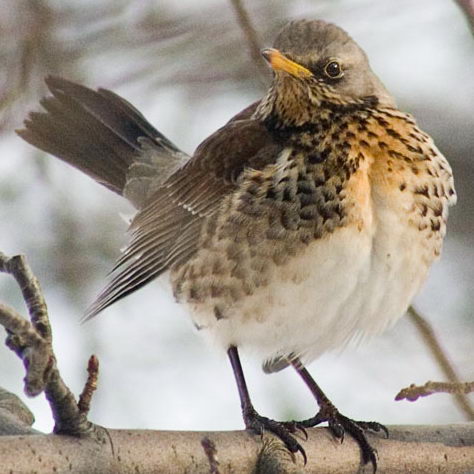- Fieldfare
Taxobox
name = Fieldfare
status = LC | status_system = IUCN3.1
status_ref =IUCN2007|assessors=BirdLife International|year=2004|id=51605|title= Turdus_pilaris|downloaded= 2 February 2008 Database entry includes justification for why this species is of least concern]

image_width = 250px
regnum =Animal ia
phylum = Chordata
classis = Aves
ordo = Passeriformes
familia = Turdidae
genus = "Turdus "
species = "T. pilaris"
binomial = "Turdus pilaris"
binomial_authority = Linnaeus,1758 The Fieldfare ("Turdus pilaris") is a member of the thrush family Turdidae. This species was first described by Linnaeus in his "Systema naturae" in 1758 under its current scientific name. [la icon cite book | last=Linnaeus | first=C | authorlink=Carolus Linnaeus | title=Systema naturae per regna tria naturae, secundum classes, ordines, genera, species, cum characteribus, differentiis, synonymis, locis. Tomus I. Editio decima, reformata. | publisher=Holmiae. (Laurentii Salvii). | date=1758| quote = T. rectricibus nigris : extimis margine interiore apice albicantibus, capite uropygioque cano. |pages=168] Its English name, dating back to at least the twelfth century, derives from the Anglo-Saxon "feld-fere" meaning "traveller through the fields", probably from their constantly moving, foraging habits.cite web|title= Fieldfare|work= |url= http://www.merriam-webster.com/dictionary/fieldfare |publisher= Merriam-Webster | accessdate=2008-02-02]
It breeds in woodland and scrub in northern
Europe andAsia . It is strongly migratory, with many northern birds moving south during the winter. It is a very rare breeder inGreat Britain andIreland , but winters in large numbers in these countries.It nests in trees, laying several eggs in a neat nest. Unusually for a thrush, they often nest in small colonies, possibly for protection from large
crow s. Migrating birds and wintering birds often form large flocks, often withRedwing s.It is omnivorous, eating a wide range of
insect s andearthworm s in summer, and berries in winter.The Fieldfare is 22-27 cm long, with a plain brown back, white underwings, and grey rump and rear head. The breast has a reddish wash, and the rest of the underparts are White. The breast and flanks are heavily spotted. The sexes are similar,
The male has a simple chattering song, and a chattering flight and alarm call.
tatus
The Fieldfare has an extensive range, estimated at 10 million square kilometres (3.8 million square miles), and a large population, including an estimated 28 to 48 million individuals in Europe alone. The species is not believed to approach the thresholds for the population decline criterion of the IUCN Red List (i.e., declining more than 30% in ten years or three generations), and is therefore evaluated as
Least Concern .References
Photos
References
* Database entry includes justification for why this species is of least concern
External links
Wikimedia Foundation. 2010.
